Pear Custard Tart with Hazelnut Crust
A new old (and Thanksgiving-friendly) recipe from my year at Coco Pazzo
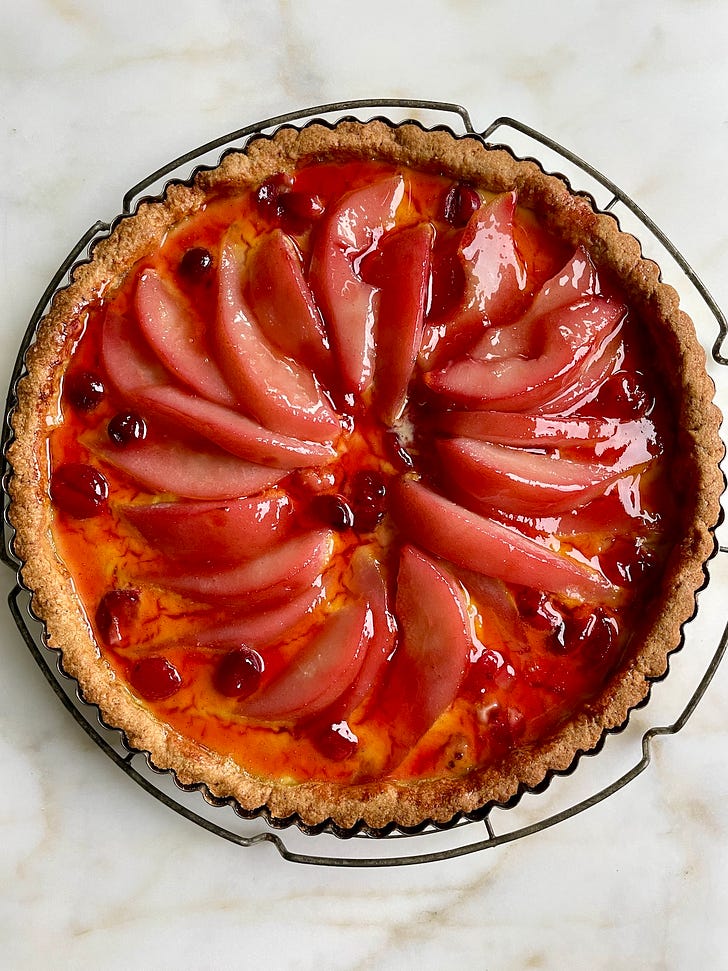
Last Friday I shared a recipe for Cranberry-Rosé Poached Pears and, in the post, mentioned that I’d recently found an old recipe card for a pear tart I made back in my days as pastry chef at Coco Pazzo. I started playing around with recreating the dessert and asked if you all would like to one day see the finished recipe here. Many of you said yes, so I decided to give this new old recipe the Susanality treatment.
An old, oily index card with spotty directions was my starting point in recreating what was a standby recipe on my dessert menu at Coco Pazzo so long ago. It was the very end of my restaurant career, and a really fun job for nine months before I began my career in media at Martha Stewart Living.
I just hopped over to The New York Times to see if this dessert was mentioned in the restaurant review that really made my day way back in 1991, and, guess what, it was! Click here to read the original review, paywall-free. Scroll to the last section for the dessert review. We were so grateful to be reviewed by Marian Burros, who was filling in for Bryan Miller, the Times’ restaurant critic at the time. He never gave 3-star reviews to Italian restaurants. We lucked out.
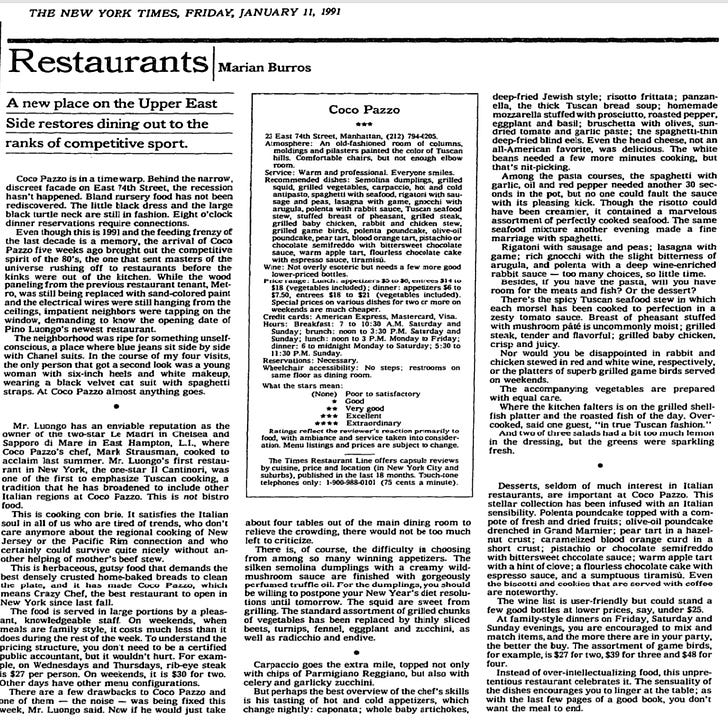
It was a trip down memory lane to revisit this delicious recipe. The original was made with dark, red wine-poached pears. When you used that ruby-hued poaching liquid for the custard, it turned it a sort of purplish pink. The pale pink liquid from the Rosé-Cranberry Poached Pears will instead leave the custard a naturally eggy yellow. The custard needs no seasoning because it’s already sweetened and redolent with ginger and vanilla from the poaching liquid.
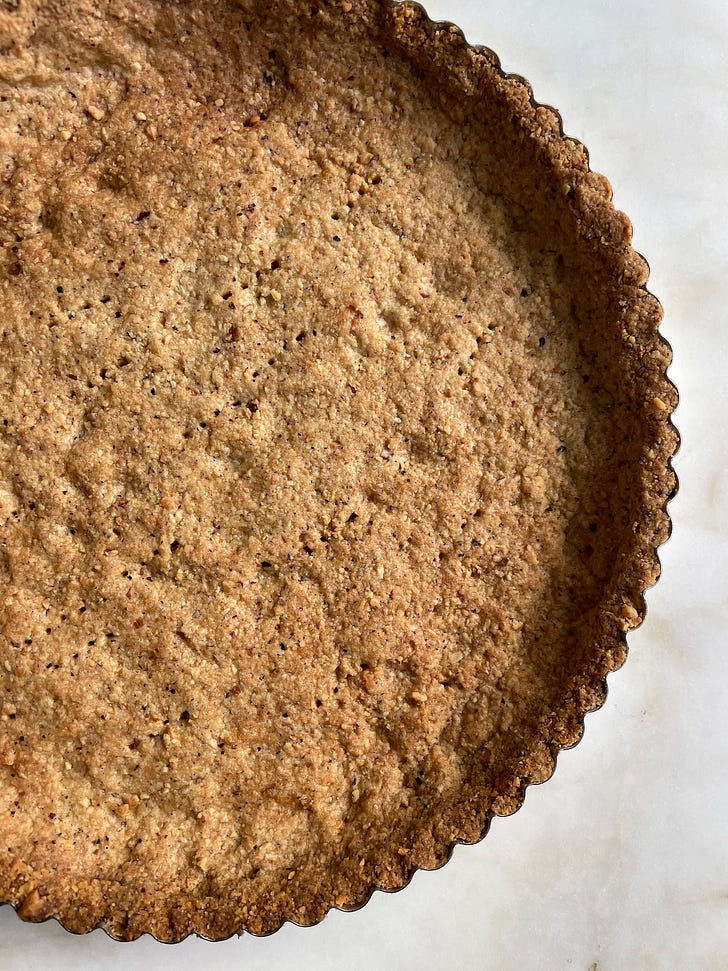
This cookie-like tart shell can be filled any way you want. It’s completely blind-baked, so it’s ready to fill with any uncooked filling (like a stirred custard, or a sweetened mascarpone), and then topped with berries or cooked fruit. Or just do as I do here and make a batch of poached pears, and then use some of them to make this delicious and beautiful tart. Like most good tarts with multiple components, the work is easier if spread over several days.
I ended up making an extra shell and froze it for a Thanksgiving dessert. I shared the finished tart at a small dinner the other night, and one guest took some home for breakfast. Good idea! It was loved by all. Hope you love it too.
Cookie season is almost here! If you want all of this year’s new cookie content to land in your inbox, consider upgrading to a paid subscription (you’ll also gain access to the previous two holiday seasons’ worth of recipes and my Great Big Cookie Guide). As a reader-supported publication, every subscription is appreciated and helps fund the butter budget for creating new content!
Pear Custard Tart with Hazelnut Crust
Serves 8 to 10
For the dough:
1 cup/128 g hazelnuts
1 cup/128 g all-purpose flour
½ cup/50 g confectioners’ sugar
¼ cup/50 g granulated sugar
¼ teaspoon kosher salt
6 tablespoons cold butter, cut into pieces
1 egg yolk
For the tart:
2 Rosé-Cranberry Poached Pears plus a few of the cranberries
¾ cup poaching liquid from Rosé-Cranberry Poached Pears
2 eggs
For the glaze:
1 cup poaching liquid from Rosé-Cranberry Poached Pears
Heat oven to 375℉. Spread hazelnuts on a small sheet pan and toast for 8 to 10 minutes (but watch carefully), shaking occasionally, until the skins are popping off and the nuts are golden. Immediately pour into a bowl and cover with a folded dishcloth. When they’re cool enough to handle, rub the skins off (click here for a visual). If they don’t all come off, it’s fine. Separate the skins from the nuts and put the nuts in the food processor.
Add the flour, confectioners’ sugar, granulated sugar, and salt. Pulse until the nuts are pretty finely ground.
Add the butter to the food processor, and pulse until fine crumbs form. Add the egg yolk and pulse until the crumbs look evenly moistened (you may need to scrape the sides if any of the yolk sticks). Transfer to a medium bowl, and mix a little more with your hands.
Transfer to a 10-inch removable bottom tart pan (it will still be in crumbs), and press it into the bottoms and sides as evenly as possible. Pay special attention to the edges, building them up a little so they don’t get too dark, and are sturdy. Chill until firm, in the freezer if possible.
Poke the shell all over with a fork. Line it with foil, and fill with dry beans or baking weights, and bake for 15 minutes. The exposed top edge of the tart should look dry and maybe starting to brown. Remove the pan from the oven, carefully remove the foil, being careful to contain the beans, and return the pan to the oven to bake 15 to 20 minutes longer until golden all over.

Cut the poached pears in half lengthwise, and remove the seeds (I like to use a melon baller). Cut each half in half again, and cut 4 or 5 wedges out of each quarter. Arrange the pear slices attractively in the tart shell.
Strain the poaching liquid to catch the cranberries, so you end up with ¾ cup. In a bowl, combine the poaching liquid with the eggs, using a whisk to mix thoroughly.
Pour the liquid (it will be very thin) into the tart shell. Sprinkle some of the cranberries around the pears. Place the tart pan on a sheet pan, and bake for 35 to 40 minutes until set in the center. Remove to a cooling rack. Let cool for 10 to 15 minutes before glazing.
To make the glaze, simmer the additional cup of poaching liquid in a small saucepan until syrupy, and brush onto the pears. Once the pears are coated, dab it onto the exposed parts of the custard. Serve warm, room temp, or cold. Refrigerate leftovers.
Tips for a nut crust:
Plunk the butter pieces around the food processor so each one is coated in flour. This will help it mix in more evenly.
Sub any portion of the hazelnuts with toasted whole almonds.
After it’s baked and cooled, gently push up on the bottom of the tart pan to make sure the crust has loosened around the edges before filling it. Use the tip of a paring knife to loosen any stuck parts.
If the shell got at all stuck, it’s easier to loosen it when it’s warm.
The baked shell can be frozen (tightly wrapped) for a month or two.

Editor: Molly Ramsey




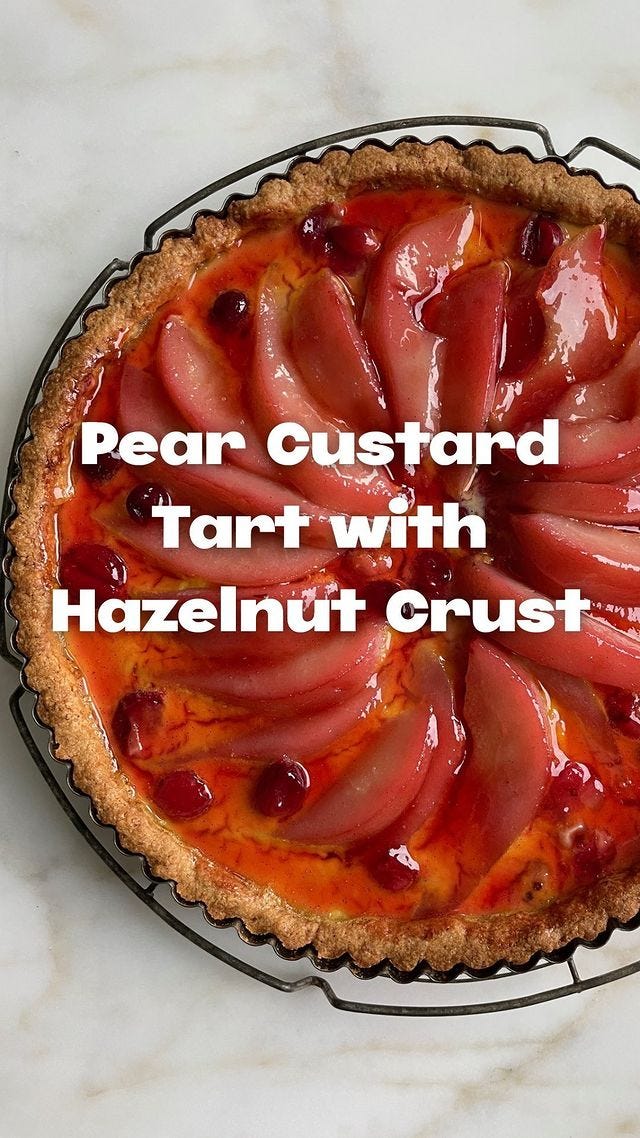
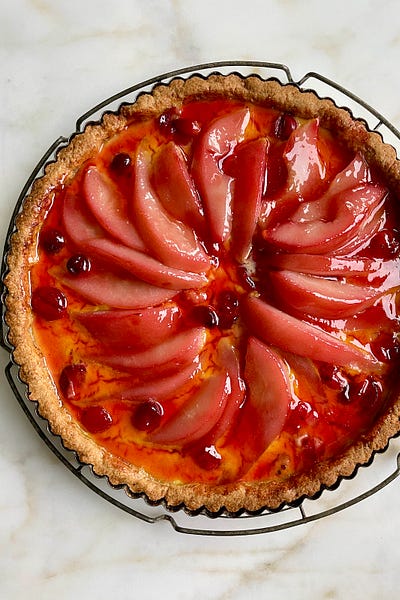
I had a big ol’ fail with this. I prebaked the crust and yet much of the custard seeped into the crust with some ending up on the cookie sheet. Really disappointing. After the tart cooled, I added the remaining poaching liquid on top in hopes of rescuing it. I’m optimistically taking it to Thanksgiving tomorrow. Fortunately, I’m confident in my apple pie.
Great Minds. This is one of my favorite fall desserts and I plan to make it for Thanksgiving: Pear Quince Tart from Chef Daniel Boulud's Cafe Boulud Cookbook p.170 https://bit.ly/3FVqU6s. BTW, Dorie Greenspan is the co-author.